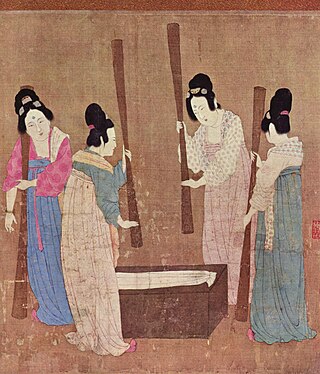Silk
fine, lustrous, natural fiber produced by the larvae of various silk moths, especially the species Bombyx mori From Wikipedia, the free encyclopedia
Remove ads
Silk is a natural fibre made by the silk worm to form their cocoon. Silk fibres are very strong, yet soft, and so are often used to make cloth.


The cloth from silk can be made into rugs, bedding, or can be used to write or paint on. In the past, silk was used to make parachutes. The practice of growing silkworms for silk production is called sericulture.
Most spiders make a natural fibre of their own that is also called silk to create spider webs.
Remove ads
History
The practice of breeding silkworms, known as sericulture, dates back to around 5000 BC during the time of the Yellow Emperor, Huang Di. Legend says that his wife, Lei Zu, introduced silkworm rearing and invented the loom, earning her the title "Goddess of Silk".[1] The Chinese began producing silk cloth by 3000 B.C., and traded it across the world throughout Asia and into Europe along the Silk Road because it was very valuable and costly. They were the only ones producing it and selling it to the world until the second century, when the silk industry spread into India and Persia.[2] In the sixth century, Christian monks stole silkworms from China. The silk from these monks played an important role in the economy of the Byzantine Empire.[3] China and India produce the most silk in modern times.[4]
Remove ads
Chemical properties
Silk that is made by the silk worm is made up of two main proteins, sericin and fibroin.
Fibroin is the structural center of the silk and gives it its strength. It is made up of amino acids, which make the fibers strong and hard to break. The tensile strength is there because of hydrogen bonds. When silk is stretched, there is a strong force on these many bonds, so they do not break.
Serecin is the sticky material which surrounds the fibroin and gives it protection from the outside. Silk is resistant to most mineral acids, except for sulfuric acid, which dissolves it. Perspiration gives the silk a yellowish colour.
Remove ads
Ethics
Silk worm cocoons are boiled to separate the fibers. This kills the pupa inside, raising ethical concerns. In response, the process of making "peace silk" was created. This process allows the pupa to hatch as adult moths before the broken cocoons are boiled. However, the moths then suffer greatly in the commercial setting, discarded to starve to death after mating or killed by grinding to analyze their remains for disease insted of being cared for,[5][6] and since the nervous system of animals breaks down in the cocoon stage,[7][8] negating senses such as pain,[9] there is far more suffering in the current "peace silk" process than in the regular silkmaking process.[5][6][10]
Related pages
References
Wikiwand - on
Seamless Wikipedia browsing. On steroids.
Remove ads
